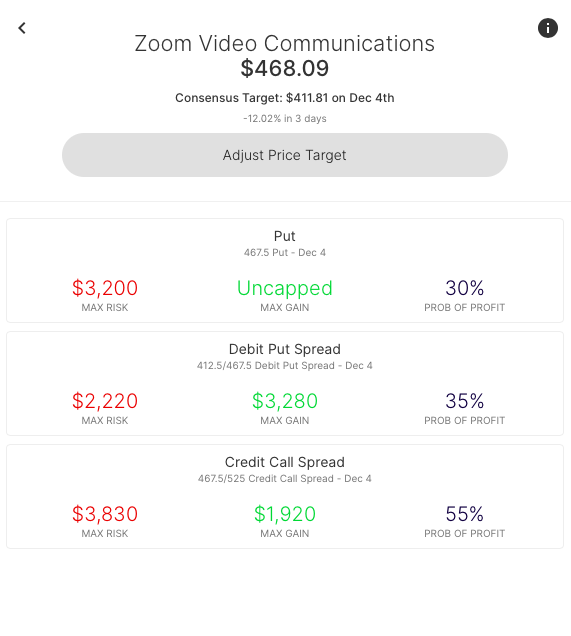The following originally appeared on Options AI
Earnings season is winding down but this week features a pretty full calendar and it's another good time to discuss event-trading using options – with particular focus on using the expected move to your advantage in price target and strike selection.
We'll focus on two big names set to report today and tomorrow, Zoom Video Communications Inc ZM and Salesforce.com, inc. CRM.
What Is The Expected Move?
The expected move is the amount that options traders believe a stock price will move up or down. It can serve as a quick way to cut through the noise and see where real-money option traders are pricing the future of a stock. On Options AI, it is calculated using real-time option prices and displayed on a chart like this in Zoom:

Knowing this consensus before making a trade can be incredibly powerful, regardless of whether you're using stock or options to make your trade. A helping hand with setting more informed price targets as well as a useful basis for starting strike selection. It can also be compared to recent actual earnings moves, for instance here are the past 3 moves for Zoom, an 18% average when taking into account the 40% move in August:
 Let's go to some trade examples, using Zoom and its expected move, roughly $57.
Let's go to some trade examples, using Zoom and its expected move, roughly $57.
With the stock $476 (intraday Monday), the bullish consensus for this Friday is about $533 and the bearish consensus near $419
Zoom – Income Generating Strategies
First, we'll look at a neutral view and income-generating trades. This is "selling the move" to both bulls and bears. A view that both buyers of calls and buyers of puts are over-estimating the size of any potential stock move. Premium (or income) received from selling options is kept if the stock stays within a range.

The Iron Condor is one strategy used for this purpose. The Iron Condor involves selling a call spread and simultaneously selling a put spread, generating upfront income to the seller and offering defined-risk if things go wrong. With four option legs involved, strike selection can be a lengthy and confusing process. But using the expected move, strikes can be set to sell to those looking for moves beyond the crowd, as seen on this chart:

Directional Trading – Bullish
Using a bullish price target, the expected move can also be used for the basis of two spread trades: in this example a debit call spread to the bullish consensus, and a credit put spread, with capped risk at the bearish consensus:

The same thinking can be used to express a bearish consensus view, with spread choices of a credit call spread, or a debit put spread:

Directional Trading Beyond the Expected Move
Those are examples for either positioning to the expected move or inside the expected move. What about outside? When you believe the market has underpriced expectations, the expected move can still be a useful guide. Taking an example price target, to $550, well outside the bullish expected move:
Here we see a debit call spread with the long call set at the current stock price and the short call at the target, but also a less expensive call spread with the long call set at the expected move and the short call at the target. (The same thinking can be used for bearish targets.)
Salesforce
Looking at Salesforce the numbers change but the concepts remain the same. Here's the expected move to this Friday with the stock $239, a bullish consensus about $255 and bearish near $224:

And here are Salesforce's past 3 earnings moves, again, with a outsized move in August and much more muted moves before:

Comparing trade types directly, we can see the difference in cost and probability of a call spread (to the expected move) versus an outright call and a credit put spread:

And a neutral / income-generating strategy with breakevens near the expected move:

Summary
The expected move can provide actionable insight to consider before making any trade, particularly into an uncertain event. Whether gut-checking your own expectations versus the options crowd, generating trade ideas from option market signals, or for more informed strike selection.
Options AI is an online brokerage. But it has just launched some educational resources and free tools, including an expected move calculator and earnings calendar. Give them a try here: learn.optionsai.com
Options AI does not provide investment, tax or legal advice and does not endorse or recommend the purchase or sale of any particular security or trading strategy. All content is meant for informational and reference purposes only. Any data or information regarding the likelihood of various investment outcomes is hypothetical in nature, does not reflect the opinions of Options AI and is not a guarantee of future results. Options transactions involve risk and are not suitable for all investors. Prior to deciding to invest in options please review the Characteristics and Risks of Standardized Options.
The post Expected moves, earnings and spread trading. Zoom, Salesforce. appeared first on Options AI: Learn.
Edge Rankings
Price Trend
© 2025 Benzinga.com. Benzinga does not provide investment advice. All rights reserved.
Trade confidently with insights and alerts from analyst ratings, free reports and breaking news that affects the stocks you care about.